I’ve been with our county’s environmental planning department for nearly 14 years. My job isn’t glamorous. It involves a lot of permits, reports, public notices, and meetings. But once in a while, you get a project that sticks with you. The kind that makes you rethink how “clean” land really is—and what your responsibility is when it’s not.
This all began with a community park initiative. We’d secured state grant funding to turn a 9-acre property into a multi-use greenspace with trails, a splash pad, and a small amphitheater. The property had once been farmland, later an equipment staging area for a now-defunct highway project. According to the records, it was clean.
Still, due diligence meant starting with a Phase I Environmental Site Assessment. Nothing in the historical review flagged major concerns. But one thing caught my eye—an old aerial photo from 1976 showing what looked like five small dark circles at the back of the property. The report listed them as “possible debris piles or buried containers.” Our project manager asked me, “Want to go take a look?”
We brought a couple of staffers and a metal detector. It was more curiosity than anything. The area had since grown over—shrubs, weeds, a few cottonwoods. The detector chirped almost immediately. One of our team members took a spade and hit metal about two feet down. It was a rusted drum lid, maybe 30 inches across. We stopped digging and called the environmental consultant that afternoon.
They arrived the next morning with ground-penetrating radar and a drill rig in tow. I still remember the lead investigator’s expression after scanning the site. “You’ve got more than a couple of drums here,” she said. “There’s a cluster of at least twelve, maybe more. We need to do a full Phase II site investigations.” That phrase changed everything. It meant the park was paused, our timelines were shot, and we were now managing something far more complex. The consultant outlined their plan: install soil borings, test for VOCs, SVOCs, metals, and PCBs, and sample down to groundwater if necessary.
We briefed our county commission and held a community meeting. People were frustrated, but also curious. Some neighbors had grown up near the field and recalled “dumping going on” during the late ’70s. “They used to bury all kinds of stuff down there,” one older man told me. “I always wondered about that.”
Lab results came back within ten days. The verdict: trichloroethylene, lead, toluene, and other chlorinated solvents in concentrations that, while not catastrophic, absolutely required remediation. The groundwater was still clean—thankfully—but the soils around the buried drums were hot.
The consultant proposed a risk-based remediation plan. It called for:
– Careful excavation of the contaminated zone
– Containerization of soil and debris
– Thermal desorption of VOCs onsite using a mobile unit
– Verification sampling to confirm cleanup standards were met
– Installation of a vapor barrier beneath any future park buildings
What impressed me most was how the plan didn’t overreach. It focused on the actual risk pathways, not the worst-case scenarios. That allowed us to stay within budget and regulatory thresholds without triggering a full-blown federal response. Our state regulator reviewed the plan and gave the green light within the week.
During excavation, 17 drums were removed. Most were empty, a few were sealed and full of sludge. Every step was photographed and documented. No surprises, no breaches. The work was surgical.
We hosted a second community meeting midway through. Tensions were lower this time. I shared the lab results, remediation design, and confirmed that the soil removal was underway. Someone asked, “Is this going to turn into a Superfund site?” The consultant calmly explained why it wouldn’t. We were transparent, factual, and respectful. That earned trust.
Once backfill and regrading were done, they placed a monitoring well for future testing and closed out the excavation. Confirmatory samples showed all levels back to background. Cleanup goals met. Documents filed.
We finally opened that park—14 months later than planned, but with peace of mind. A community garden sits where the drums were pulled out. Kids play on the splash pad. No one would ever guess what had been buried beneath.
Internally, we made procedural changes. All future site developments on parcels over five acres must include Phase II site investigations if there’s any indication—however minor—of historical industrial or staging use. Our default used to be optimism. Now it’s evidence.
And the remediation lessons went even deeper. We now embed risk-based remediation plans into our budgeting cycles early, so surprises don’t derail everything. Risk is part of the job. But managing that risk, with good science and community trust, is where public sector leadership really shows.
I still walk through that park and remember the hidden story beneath my feet. That’s why diligence matters.




